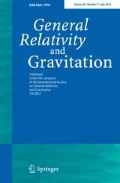Abstract
In the general relativistic description of gravitation, geometry replaces the concept of force. This is possible because of the universal character of free fall, and would break down in its absence. On the other hand, the teleparallel version of general relativity is a gauge theory for the translation group and, as such, describes the gravitational interaction by a force similar to the Lorentz force of electromagnetism, a non-universal interaction. Relying on this analogy it is shown that, although the geometric description of general relativity necessarily requires the existence of the equivalence principle, the teleparallel gauge approach remains a consistent theory for gravitation in its absence.
Similar content being viewed by others
REFERENCES
Hehl, F. W., McCrea, J. D., Mielke, E. W., and Ne'emann,Y. (1995). Phys. Rep. 258, 1; Blagojevi?, M. (2002). Gravitation and Gauge Symmetries, IOP Publishing, Bristol, United Kingdom.
Hammond, R. T. (2002). Rep. Prog. Phys. 65, 599.
Hayashi, K. and Shirafuji, T. (1979). Phys. Rev. D 19, 3524.
Obukhov, Y. N. and Pereira, J. G. (2003). Phys. Rev. D 67, 044016.
de Andrade, V. C. and Pereira, J. G. (1997). Phys. Rev. D 56, 4689.
Synge, J. L. (1960). Relativity: The General Theory, Wiley, New York.
Damour, T. (2001). In Comptes Rendus de l'Academie des Sciences (Paris), C. Bordé and P. Touboul (Ed.) (gr-qc/0109063).
Aldrovandi, R. and Pereira, J. G. (1995). An Introduction to Geometrical Physics, World Scientific, Singapore.
de Andrade, V. C., Guillen, L. C. T., and Pereira, J. G. (2000). Phys. Rev. Lett. 84, 4533.
Landau, L. D., and Lifshitz, E. M. (1975). The Classical Theory of Fields, Pergamon, Oxford.
Aldrovandi, R., Barros, P. B., and Pereira, J. G. (2003). Gen. Rel. Grav. 35, 991.
Will, C. M. (2001). Living Rev. Relat. 4, 4; Haugan, M. P., and Lämmerzahl, C. (2001). Lect. Notes Phys. 562, 195.
de Andrade, V. C., Guillen, L. C. T., and Pereira, J. G. (2001). Phys. Rev. D 64, 027502.
Misner, C. W., Thorne, K. S., and Wheeler, J. A. (1973). Gravitation, Freeman, New York.
Lämmerzahl, C. (1996). Gen. Rel. Grav. 28, 1043; Lämmerzahl, C. (1998). Acta Phys. Polon. 29, 1057; Chiao, R. Y. (2003). In Wheeler's 90th Birthday Symposium Proceedings, Cambridge University Press, Cambridge, United Kingdom (gr-qc/0303100).
Fock, V. A. and Iwanenko, D. (1929). Z. Phys. 54, 798.
Author information
Authors and Affiliations
Rights and permissions
About this article
Cite this article
Aldrovandi, R., Pereira, J.G. & Vu, K.H. Gravitation Without the Equivalence Principle. General Relativity and Gravitation 36, 101–110 (2004). https://doi.org/10.1023/B:GERG.0000006696.98824.4d
Issue Date:
DOI: https://doi.org/10.1023/B:GERG.0000006696.98824.4d




